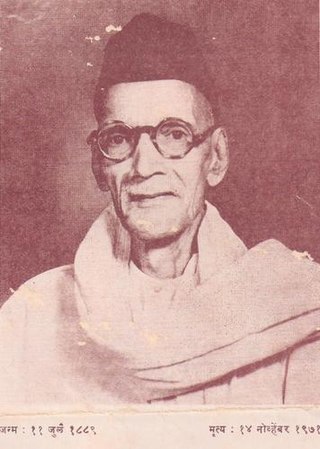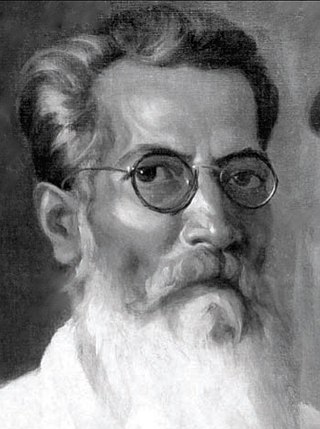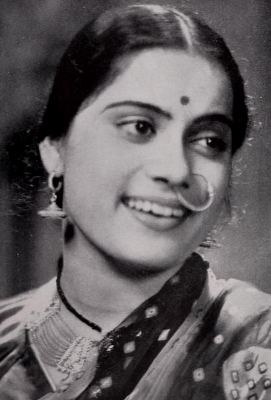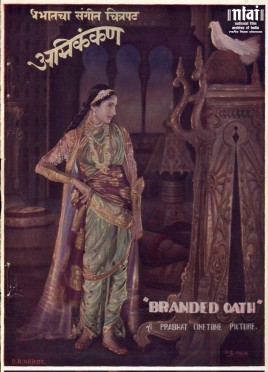
Tanaji Kaloji Malusare or Subedar Tanaji Malusare was a military commander of the Maratha kingdom and a companion of Shivaji. A local poet Tulsidas, wrote a powada describing Subhedar Tanhaji's heroics and sacrifice of life in the Battle of Sinhagad, which has since made him a popular figure in Indian folklore.

Baji Prabhu Deshpande was a general of the Maratha Army. He is known for his role in the Battle of Pavan Khind at Ghod Khind, where he sacrificed his life defending Shivaji Maharaj from incoming Adil Shahi forces of Siddi Johar. He also was a landlord or Vatandar in the Maval region.

Sinhagad is an ancient hill fortress located at around 49 km southwest of the city of Pune, India.

The Battle of Sinhagad, also known as Battle of Kondhana, involved an attack by Marathas during the night of 4 February 1670 on the Mughal fort of Sinhagad, near the city of Pune, Maharashtra. The Marathas captured the fort.
The powada is a genre of Marathi poetry that was during the late 17th century in India. Powada, which means ‘to glorify’, is a traditional Marathi ballad that traces its history to more than 750 years Powadas often glorified and celebrated deeds of popular folk figures and leaders such as Chhatrapati Shivaji and Tanaji Malusare, and were also written to raise awareness on social issues such as female foeticide, dowry and corruption. Powadas were also used as a medium to create awareness during Samyukta Maharashtra movement.

Narayan Hari Apte, popularly known as Nanasaheb Apte was a Marathi popular novelist, writer of advice books and editor from Maharashtra, India.

Baburao Krishnarao Mestry, popularly known as Baburao Painter was an Indian filmmaker and artist. He was a man of many talents with proficiency in painting, sculpture, film production, photography, and mechanical engineering.

Bhalji Pendharkar was a film personality in India, and recipient of Dadasaheb Phalke Award, the most prestigious award in the field.

Dinkar D. Patil (1915–2005) was a prominent Marathi film director, scriptwriter, and dialogue writer during the Golden Era (1950–1990) of the Marathi cinema. He directed, wrote scripts and dialogue for more than 60 Marathi films. He also directed two Hindi films – Mandir and Gharbar. He wrote his famous autobiography titled as Patlache Por.

Udaykal is a 1930 historical silent film co-directed by V. Shantaram and Keshavrao Dhaiber. It was produced by Prabhat Film Company. The story was written by Baburao Pendharkar. The cinematographers were S. Fattelal and V. G. Damle. The film starred V. Shantaram, Baburao Pendharkar, Kamla Devi, G. R. Mane, Ibrahim and Dhaiber.
Rani Saheba also called Bazarbattu is a 1930 Indian silent film. It is cited as the first children's film made in India. The film was co-directed by V. Shantaram and Keshavrao Dhaiber. The cinematographers were S. Fattelal and Vishnupant Govind Damle and the cast included Keshavrao Dhaiber, Baburao Pendharkar, V. Shantaram and Anant Apte.

Ladki Sahyadri Ki is a 1966 Hindi social drama film directed by V. Shantaram. Also called Iye Marathichiye Nagari in Marathi, it was a bilingual for V. Shantaram productions under the Rajkamal Kalamandir banner. The music was composed by Vasant Desai, with lyrics by Bharat Vyas. The cast included Sandhya, Shalini Abhyankar, Vatsala Deshmukh, Kumar Dighe, Keshavrao Date, and Baburao Pendharkar.
Khooni Khanjar is a 1930 Indian silent film directed by V. Shantaram. The film was a costume action drama film co-directed by Keshavrao Dhaiber. It was produced by Prabhat Film Company. The cinematography was by Sheikh Fattelal and Vishnupant Govind Damle. The cast included Mane Pahelwan, Ganpat G. Shinde, P. Jairaj, Sakribai and Shankarrao Bhosle.

Shanta Apte (1916–1964) was an Indian actress-singer who worked in Marathi and Hindi cinema. Renowned for her roles in films like Duniya Na Mane/Kunku (1937) and Amar Jyoti (1936) under the Prabhat Films banner, she was active in Indian cinema from 1932 to 1958. Apte's impact on Marathi cinema "paralleled" that of Kanan Devi in Bengali cinema. Along with Kanan Devi, Apte is cited as one of the "great singing stars" from before the playback singing era. Apte began her career in films playing the role of a young Radha in the Marathi film Shyamsunder (1932). She joined Prabhat Films acting in her first Hindi language film Amrit Manthan in (1934).

Agnikankan: Branded Oath also called The Branded Oath, is a 1932 Marathi adventure film directed by V. Shantaram. The film was a Prabhat Film Company production and was a bilingual, called Jalti Nishani in Hindi. The cinematography was done by Keshavrao Dhaiber and Art direction by S. Fatehlal. The sound direction was by Vishnupant Govind Damle and the music and lyrics were by Govindrao Tembe. Dialogues for the movie are written by Govindrao Tembe. The character artist Gajanan Jagirdar began his career in films by acting the role of a seventy-five-year-old man at the age of twenty-five. The cast included Shankarrao Bhosle, Kamala Devi, Master Vinayak, Baburao Pendharkar, Nimbalkar and Jagirdar.
Shri Shivraj Ashtak is an Indian Marathi-language historical drama film series created by Digpal Lanjekar. The franchise started off with an eight-part film series written and directed by Lanjekar based on Maratha Empire. The first film Farzand released on 1 June 2018 and was followed by 6 films: Fatteshikast (2019), Pawankhind (2022), Sher Shivraj (2022), Subhedar (2023), Shivrayancha Chhava (2024).











